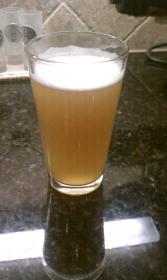Sorry, slightly off topic- but...Anyone have the problem of losing flavor superfast with this beer? I am wondering if that's just normal, or if there is something I can fix. My brew day was text-book. I did a multistep mash with protein rest, and the boiling and chilling went as expected. I did get a "low" efficiency at 69%. I had planned to ferment in the basement at 60 deg after it took off. So my plastic bucket fermenter was in 75+ ambient temp for ~ a day, then down to 60. Fermentation really slowed, so after 3 or 4 days I brought it back upstairs and it took off again. I left the beer in primary for almost 3 weeks before bottling. After 5 days carbing, this was the BEST beer I've made yet. Huge banana flavor, nice clove finish. And now 2 weeks later it is losing flavor fast, almost a bit of sulphur taste. What could be my problem. I know there are a few things I might be able to fix... One of them being the odd shaped bottles I used. They were hard to cap properly, cause the necks were not standard. I will try regular bottles and O2 absorbing caps next time. What else? Was my fermentation temp swings too much? Did I leave on the trub/yeast too long? Help! My beer is not bad by any means, it's just not as good as it was.








